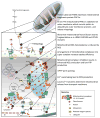Current perspective of mitochondrial biology in Parkinson's disease
- PMID: 29550604
- PMCID: PMC6027640
- DOI: 10.1016/j.neuint.2018.03.001
Current perspective of mitochondrial biology in Parkinson's disease
Abstract
Parkinson's disease (PD) is one of the most common neurodegenerative movement disorder characterized by preferential loss of dopaminergic neurons of the substantia nigra pars compacta and the presence of Lewy bodies containing α-synuclein. Although the cause of PD remains elusive, remarkable advances have been made in understanding the possible causative mechanisms of PD pathogenesis. An explosion of discoveries during the past two decades has led to the identification of several autosomal dominant and recessive genes that cause familial forms of PD. The investigations of these familial PD gene products have shed considerable insights into the molecular pathogenesis of the more common sporadic PD. A growing body of evidence suggests that the etiology of PD is multifactorial and involves a complex interplay between genetic and environmental factors. Substantial evidence from human tissues, genetic and toxin-induced animal and cellular models indicates that mitochondrial dysfunction plays a central role in the pathophysiology of PD. Deficits in mitochondrial functions due to bioenergetics defects, alterations in the mitochondrial DNA, generation of reactive oxygen species, aberrant calcium homeostasis, and anomalies in mitochondrial dynamics and quality control are implicated in the underlying mechanisms of neuronal cell death in PD. In this review, we discuss how familial PD-linked genes and environmental factors interface the pathways regulating mitochondrial functions and thereby potentially converge both familial and sporadic PD at the level of mitochondrial integrity. We also provide an overview of the status of therapeutic strategies targeting mitochondrial dysfunction in PD. Unraveling potential pathways that influence mitochondrial homeostasis in PD may hold the key to therapeutic intervention for this debilitating neurodegenerative movement disorder.
Keywords: Mitochondrial DNA; Mitochondrial dynamics; Oxidative phosphorylation; Parkinson's disease; Permeability transition pore; Reactive oxygen species.
Copyright © 2018 Elsevier Ltd. All rights reserved.
Conflict of interest statement
Figures
References
-
- Abdelkader NF, Safar MM, Salem HA. Ursodeoxycholic Acid Ameliorates Apoptotic Cascade in the Rotenone Model of Parkinson’s Disease: Modulation of Mitochondrial Perturbations. Mol Neurobiol. 2016;53:810–817. - PubMed
-
- Abeliovich A, Gitler AD. Defects in trafficking bridge Parkinson’s disease pathology and genetics. Nature. 2016;539:207–216. - PubMed
-
- Agarwal S, Yadav A, Chaturvedi RK. Peroxisome proliferator-activated receptors (PPARs) as therapeutic target in neurodegenerative disorders. Biochem Biophys Res Commun. 2017;483:1166–1177. - PubMed
-
- Ahuja M, Ammal Kaidery N, Yang L, Calingasan N, Smirnova N, Gaisin A, Gaisina IN, Gazaryan I, Hushpulian DM, Kaddour-Djebbar I, Bollag WB, Morgan JC, Ratan RR, Starkov AA, Beal MF, Thomas B. Distinct Nrf2 Signaling Mechanisms of Fumaric Acid Esters and Their Role in Neuroprotection against 1-Methyl-4-Phenyl-1,2,3,6-Tetrahydropyridine-Induced Experimental Parkinson’s-Like Disease. J Neurosci. 2016;36:6332–6351. - PMC - PubMed
-
- Alavian KN, Beutner G, Lazrove E, Sacchetti S, Park HA, Licznerski P, Li H, Nabili P, Hockensmith K, Graham M, Porter GA, Jr, Jonas EA. An uncoupling channel within the c-subunit ring of the F1FO ATP synthase is the mitochondrial permeability transition pore. Proc Natl Acad Sci U S A. 2014;111:10580–10585. - PMC - PubMed
Publication types
MeSH terms
Grants and funding
LinkOut - more resources
Full Text Sources
Other Literature Sources
Medical
Miscellaneous


